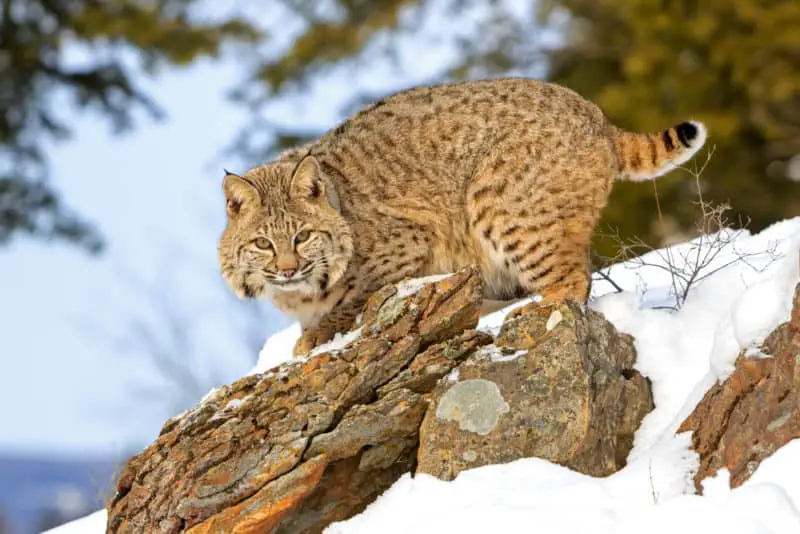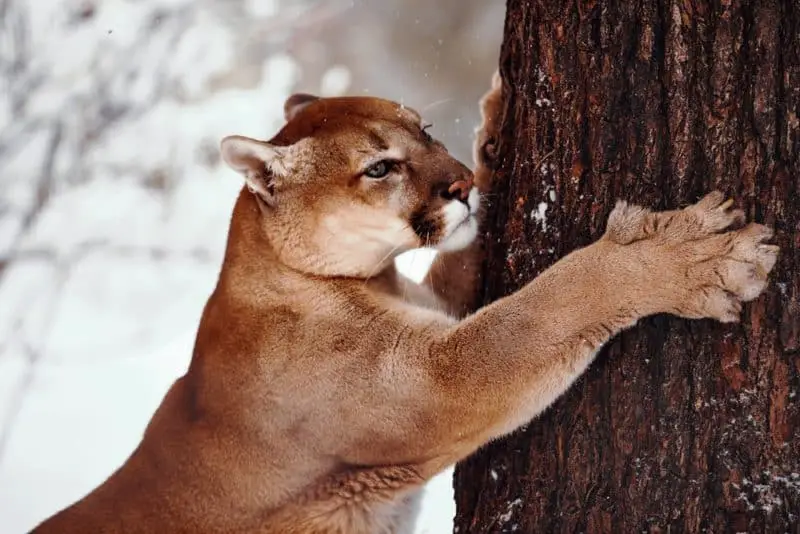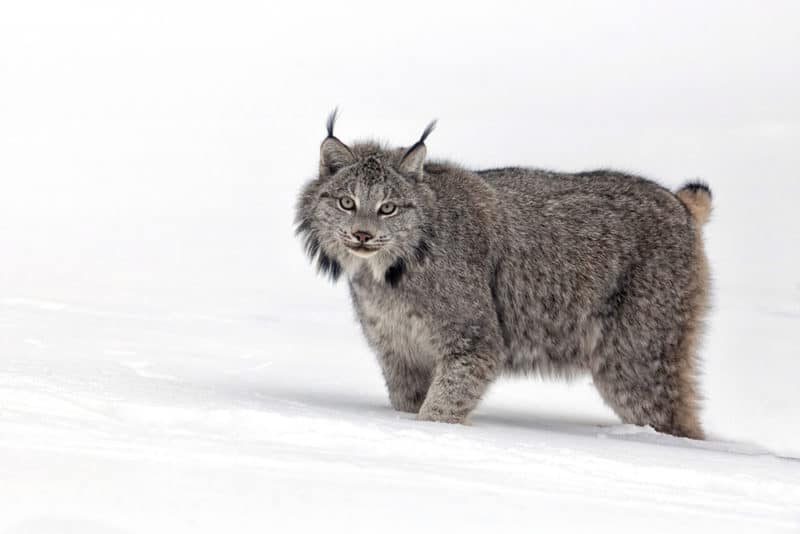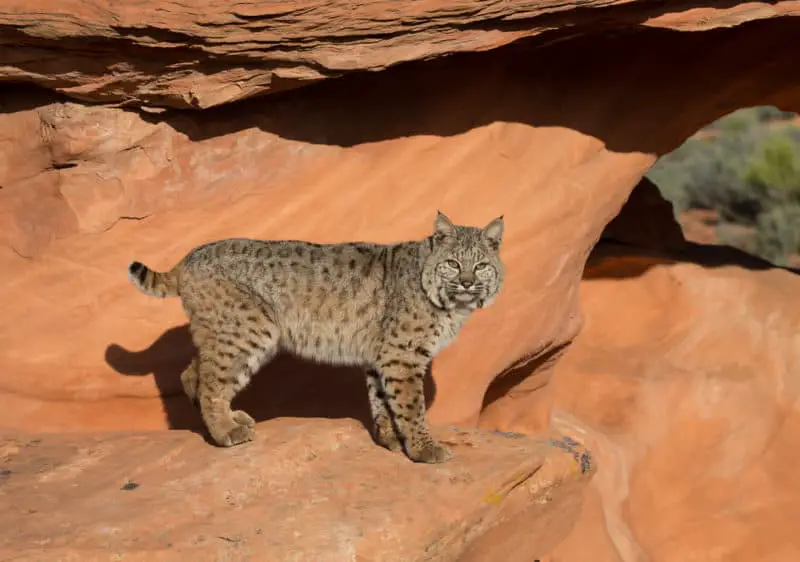The state of Utah is possibly home to 3 different species of wild cat. The state undoubtedly has mountain lions and bobcats. The Canada lynx also probably resides within the state in small numbers.
Utah’s Bobcats (Lynx rufus)
The Bobcat, which is also known as the red lynx, is a North American wild cat. Biologists believe that both the bobcat and the Canada lynx are descendants of the Eurasian lynx whose ancestors crossed into North America via the Bearing Sea land bridge.
Bobcats reside only in North America. Their range begins in Canada. Central British Columbia is the furthest north that bobcats live. Their range extends south through the United States and down into central Mexico.

What do bobcats look like?
A bobcat is much smaller than a mountain lion and slightly smaller than a Canadian lynx. In fact, smaller female bobcats are not much bigger than large domestic cats.
A bobcat is 2 to 3 feet long and weighs about 15 to 35 pounds. A Female bobcat is quite a bit smaller than a male.
These animals have a “bobbed,” short tail with black bands on its upper surface. Their tail also has a black tip on its upper surface but not the back. Their fur is usually gray to brown, with mottled dark spots that range from black to dark brown on their bodies. They also have black stripes on their inner forelegs and tail.
From a side view, you will notice that a bobcat is slightly higher at the rump than at the shoulders. Bobcats and lynx have long hind legs in proportion to their forelegs.
Bobcats have black-tufted ears. In other words, they have tufts of hair that poke up above their ears and are black at the tips. The backs of their ears, below the black tips, are black. In the center of the black of each ear, they have a single white spot. This gives the impression of a false eye on the back of each ear.
They also have a whiskered face that seems broader due to their long ruffled facial hair and whiskers. Their eyes are yellow with round black pupils.
What do bobcats eat?
Despite their comparatively small size, bobcats are aggressive, tough predators. At times, particularly during the winter, they prey on animals that are much larger than they are, such as deer. However, their regular diets mainly consist of small mammals, reptiles, birds, and carrion. When they take up residence close to a residential area, their menu might occasionally also include small pets.
Interestingly, they even prey on rattlesnakes even though they are not immune to rattlesnake venom. They accomplish this by using their quickness to pin the snake’s head down with a paw, after which they dispatch the snake with a quick bite to its spine behind the head.
Bobcat Hunting and Trapping in Utah
In Utah, bobcats are classified as furbearers. It is legal to hunt and or trap them in season with the applicable permits. Contact your regional Utah Division of Wildlife Resources office or look online @ wildlife.utah.gov for more information.

Mountain Lion (Puma concolor)
Due to the fact that they live in a wide geographical area, mountain lions have a long list of regional names. In recent years, their scientific name was even changed from Felis concolor to Puma concolor. Some common names that mountain lions go by are cougar, panther painter, Andean Mountain lion, and puma.
In Utah, the mountain lion is an apex predator. So is the black bear. The Grizzly bear and the gray wolf were once apex predators in Utah but have since been expatriated from the state. According to the Utah Division of Wildlife Resources, there have been wolves sighted in the state in recent years, but so far, these have all been young male wolves passing through the state from established wolf territory in Wyoming.
The Utah Division of Wildlife Resources estimates that there are around 2,700 cougars in the state.
Where are mountain lions typically found?
Mountain lions live on all three of the American continents. Their range begins in Canada’s Yukon territory and extends south through parts of North America, Central America, and South America to the southern tip of Argentina.
In Canada, the biggest populations of them are in British Columbia and Alberta. On the other hand, in the United States, they mainly live in the western states and Florida in the southeast. In Florida, the cougar is called the Florida panther.
The vast majority of Utah is potential mountain lion country. They live anywhere from the high mountains to the oak brush and mountain mahogany covered hillsides to the sagebrush steppes. Additionally, they live in the desert country of the Great Basin. Their habitat is anywhere that their favorite quarry, the mule deer, is found.
Urban Mountain Lions
Along Utah’s Wasatch Front, the urban areas go right up into the foothills of the mountains, and occasionally a confused cougar will end up in Salt Lake City. Here are a couple of quotes from the Park City News. “Home security systems have made mountain lion sightings a common occurrence in recent years. Darren Debloois, game mammals program coordinator for the state Division of Wildlife Resources, has advice on coexisting with big cats.”
“Mountain lions (also known in Utah as cougars) are most active hunting at dusk and dawn. “Once human activity picks up…they retreat back to the wild, so it’s rare for people to see them.”
“Debloois recommends being aware of surroundings, but there’s no need for fear. Don’t have pets or small children out unattended at dusk or dawn. Be careful with hobby-pets, like llamas or donkeys, that live outdoors at those hours as well; those pets should have shelters they can access for safety. If possible, don’t leave pet food outside.”
What do mountain lions look like?
To visualize what a mountain lion looks like, picture a giant house cat with short tan hair. Mountain lions are much larger than domestic cats, though. Average house cats weigh in at around 10 pounds, while male mountain lions can weigh over 200 pounds.
These animals have lean, muscular bodies, rounded heads, and upright ears that are oval at the tip. Another characteristic of the mountain lion is its long, black-tipped tail, which accounts for almost one-third of its entire length. They use their long tail for a counterbalance, moving it from side to side as they navigate through uneven terrain.
Mountain lions have a light brown coat of short, coarse hair over most of their body. The area around their nose, the tip of their tail, and the tips of their ears are black. Their belly, the area above their upper lip, below their lower lip, and their chin are all white. They also have a sprinkling of dark hair on their backs. There are some coat color variances between different geographic locations.
Mountain lions are the fourth largest wildcat in the world. They are smaller in size only than the Jaguar in the Americas. However, worldwide, the African Lion and the Tiger are also larger.
Male and female mountain lions are phenotypically identical in every respect except for size. Males are 30 to 40% bigger than females. Though sizes vary considerably throughout the cat’s geographic range, an adult male typically weighs between 110 and 180 pounds, 50 to (82 kgs). A rare few of them grow bigger than 200 pounds (91kgs). Female mountain lions or queens average between 80 and 130 pounds (36 to 59 kgs). Adult males or toms will reach a length of 6 to 8 feet (1.8 to 2.4 M) from their snout to the tip of their tail. On the other hand, adult females are 5 to7 feet long (1.5 to 2.1 M).
A fun fact is that despite their large size, they are not taxonomically classified as big cats because they cannot roar. Leopards, for example, are smaller than mountain lions, but since they can roar and cannot purr, they are classified as big cats, while mountain lions are not. Another interesting thing that I can mention here is that mountain lions purr.
Since they purr and cannot roar, mountain lions are in the Felis genus, while big cats that cannot purr and can roar are in the Panthera genus.
As of the year 2017, mountain lions are taxonomically divided into 2 sub-species. The first is (Puma concolor couguar) or northern cougar. Northern cougars range through North America, Central America, and possibly northwestern South America. The second sub-species is (Puma concolor concolor) or southern cougar. These cats range only in South America.
What do mountain lions eat?
In Utah, the number of mountain lions are directly correlated to the health of the state’s mule deer populations. Cougars mainly prey on deer. In fact, on average, an adult mountain lion kills a deer once a week. They also prey on other animals.
In Utah, mountain lions prey on mule deer, Rocky Mountain elk, moose, bighorn sheep, desert bighorn sheep, mountain goats, pronghorns, feral horses, coyotes, raccoons, rabbits, birds, pack rats, various small rodents, porcupines, skunks, snakes, pets, livestock, and any other native wild animals they can catch.
Mountain Lion Behavior
Mountain lions are solitary animals. It’s a Rarity to see 2 or more together unless during mating or in the case of raising young. They have expansive home territories.
An adult male’s home range is normally more than 100 square miles and up to 250 square miles. They sometimes mark their territory by leaving claw marks on trees. They also scratch up piles of leaves and or pine needles that they urinate on as scent markers. Male mountain lions fight to the death sometimes to defend their territory.
A mountain lion is a formidably tough wild animal. They can run 40 to 50 miles per hour for short bursts and jump up to 40 feet with a running start. They can also leap 15 feet vertically from a flat-footed start. See
Mountain Lion Hunting in Utah
The state of Utah classifies mountain lions as game animals. You can hunt them in the state in season with the applicable permit. Contact your regional Utah Department of Wildlife Resources Office for more information, or look here.

Canada Lynx in Utah (Lynx canadensis)
The Canada Lynx is sometimes also known as the Canadian Lynx. They are medium-sized wild cats that live in the boreal forest in the mountainous areas of Canada and the northern United States. They are 1 of 2 North American members of the “Lynx” genus. The other one is the bobcat.
The Utah Division of Wildlife Resources believes there are Canada lynx in the state. However, lynx are elusive, secretive creatures. Their presence and or abundance is difficult to document.
In 1931 a hunter shot a lynx in Emery County. Any additional evidence that there are still lynx in Utah is pretty sparse. Some lynx tracks were found in the Uinta Mountains in 1982, and some lynx hair was collected from a “hair snare” in the Manti-La Sal National Forest in 2002.
In 2004 wildlife officials from the Utah Division of Wildlife Resources captured a radio collared Canada lynx in Emery County that had wandered into Utah from Colorado and returned it back to Colorado wildlife officials. Subsequently, in 2006 Utah wildlife officers captured 2 more radio collared Colorado lynx and returned them to Colorado wildlife officials.
Regarding hair snares, wildlife officials set up hair snares which are pieces of carpet with small nails protruding out to collect animal hair. They infuse the carpet with beaver castor and catnip to entice any wild cat species in the area to rub on it, thereby collecting a hair sample for genetic analysis.
The U.S Fish and Wildlife Service listed Canada lynx in the contiguous United States as threatened under the Endangered Species Act in the year 2,000.
Canada Lynx Characteristics
What does a Canadian lynx look like? The Canadian Lynx closely resembles its close relative, the bobcat but with some differences. First of all, they are slightly larger than bobcats. They are up to 35 1/2 inches (90 cm) long and 26 inches (65 cm) tall. Additionally, they weigh up to 37 and a half pounds (17 kg). While the tail of a bobcat is short or “bobbed,” a lynx’s tail is shorter still.
Lynx don’t have the black bands on the topside of their tails that bobcats have. However, they do have black tips on the ends of their tails. One more difference is that the black tip on a lynx’s tail surrounds the entirety of the tail as if the tail had been dipped in black paint. On the other hand, a bobcat’s black tip is only on the top side of the tail.
Canada Lynx have long thick grey fur in the winter. By summertime, they have shed their grey fur and have a thinner, shorter reddish brown hair coat instead. Their color is more uniform than that of bobcats. While bobcats have black spots and mottled coloration over their entire body, Lynx are solid tan except for some mottled darker brown spots on their legs.
Canadian Lynx have triangular pointed ears with black backs and long tufts of black hair on the tips. The hair tufts are much longer than a bobcat’s. They also have drooping flared facial ruff of white hair on the sides of their face beneath their chin.
Their eyes are green with round black pupils.
Lynx have long legs in proportion to their bodies, with their hind legs being slightly longer than their front ones. This gives their body a peculiar, downhill-sloped appearance.
Canadian Lynx have almost comical-looking oversized fur-covered paws. They put their larger feet to good use. Their large paws function like snowshoes, allowing them to travel and hunt on top of the snow. Canadian lynx feet can keep almost twice as much weight from sinking into the snow as those of a bobcat. This is why they range over the deep snow country of northern Canada while bobcats do not.
What do Canada Lynx eat?
Mice, squirrels, ptarmigan, grouse, ducks, deer, Dall sheep, and caribou make up a minor portion of a Canadian lynx’s diet in regions where these prey animals are available. However, over most of their range, their preferred food is Snowshoe hares.
Lynx and Snowshoe Hare
The Canada lynx is very dependent on snowshoe hares as a food source. In some areas, hares comprise 75 percent of their total diet. In fact, their population density is directly correlated with the snowshoe hare population.
Canadian and Alaskan Canadian Lynx and snowshoe hares go through what is known as the Lynx-Snowshoe Hare Cycle. When food sources are abundant for hares, their population increases very rapidly since they can have several litters per year. When hare populations are at their peak, there can be as many as 1500 animals per square kilometer (3913 per square mile). At this time, the population of Lynx and other predators are also at their peaks.
In Utah, Canada lynx would chiefly be dependent on snowshoe hares as prey animals. However, they also feed on deer, squirrels, various other small mammals, birds, and carrion.
You might also like:
- Wild Cats in Colorado – Krebs Creek
- Wild Cats in Washington State – Krebs Creek
- Wild Cats In California – Krebs Creek
- Wild Cats In Nevada – Krebs Creek
- Wild Cats of Texas – Krebs Creek
- Wild Cats In Arizona – Krebs Creek
Recent Posts
The only venomous snakes in Washington State are Northern Pacific Rattlesnakes. The Northern Pacific Rattlesnake (Crotalus oreganus oreganus) is a sub-species of the Western Rattlesnake. Anyone...
Skunks are not classified as true hibernators. But they go into a state of torpor when the weather gets cold. Skunks are light sleep hibernators, along with opossums, bears, and raccoons. ...

